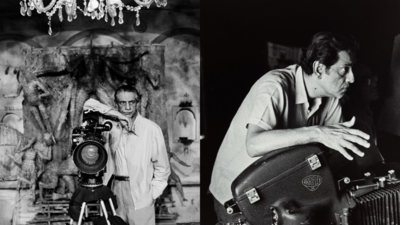ARTICLE AD BOX

The Alipore Museum, in collaboration with DAG, is set to host an exhibition showcasing photographer Nemai Ghosh's extensive documentation of Satyajit Ray
KOLKATA: The Alipore Museum, in collaboration with DAG, will host photographer Nemai Ghosh’s decades-long documentation of the esteemed filmmaker Satyajit Ray, featuring both black-and-white and previously unseen colour photographs starting Friday.The exhibition, titled 'Light and Shadow: Satyajit Ray through Nemai Ghosh’s Lens', will be open to the public until September 13, 2025. It will present a detailed portrayal of Ray, one of India’s most celebrated filmmakers, and offer insights into his life and creative process through numerous iconic and rare images. These photographs include actors, scenes, sets, and locations from Ray’s films, as well as the director at work.While primarily recognized for documenting Ray’s films and the filmmaker himself, the exhibition also highlights Ray’s extensive documentation of his cinema that is less widely known. This collection serves as a tribute to Ray, showcasing Ghosh’s photographs as a testament to Ray’s extraordinary life and his storytelling through the lens.
“Ray’s dedication to his craft led Ghosh to follow him like a shadow and conditioned him to the exacting demands of the maestro.
Over the course of a 25-year association that began on the sets of Goopy Gyne Bagha Byne, Ghosh remained steadfast in upholding the values that defined Ray’s artistic vision. In Ray, Ghosh found not just a filmmaker but a mentor and friend; no other director’s set quite measured up. With Ray’s encouragement, what began as a passion evolved into a profession, and Ghosh was eventually credited as ‘Unit Stills Photographer’," said DAG chief executive officer and managing director Ashish Anand.Nemai Ghosh’s photography extended beyond Ray’s film sets into his personal life. Ghosh frequently visited Ray’s home and often captured him playing the piano, working at his drawing board, or conversing quietly with friends and family. He photographed Ray in moments of deep reflection, whether at home, in his studio, or on location, portraying him akin to a meditative yogi. Through solitary walks, lighter moments during shoots, and silent contemplation in open fields, Ghosh created a nuanced and human portrait of the filmmaker.
These candid images form a significant part of Ghosh’s visual biography of a man he viewed as both extraordinary and grounded.Ghosh’s photography explored Ray’s multifaceted talent in every aspect of filmmaking, including scriptwriting, set and costume design, camera operation, editing, music composition, and directing. Ray was known for crafting psychologically complex stories, favouring naturalistic dialogue and often casting non-professional actors.
His direction emphasized spontaneity and subtle emotional depth, frequently requiring minimal takes while maintaining a meticulous artistic vision, influenced by his painterly background from Santiniketan to create visually and emotionally resonant films.
Deeply influenced by neo-realism, particularly De Sica’s Bicycle Thieves, and Jean Renoir’s humanistic storytelling, Ray’s cinema exhibits a lyrical quality that transcends time and place.The photographs not only document Ray’s cinema but also reflect the profound understanding between Ghosh and Ray, enabling Ghosh to place his camera precisely yet unobtrusively within the action.



.png)
.png)
.png)
















 2 days ago
9
2 days ago
9









 English (US) ·
English (US) ·